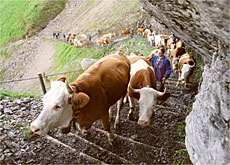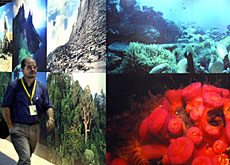Scientists sound alarm over biodiversity

Increasing numbers of plants and animals in Switzerland are dying out through loss of habitat, according to a report on the nation’s biodiversity.
Scientists are now calling on the government to install a national strategy to help save the country’s wildlife.
The report, entitled “Biodiversity in Switzerland”, was presented in Bern on Wednesday by the Swiss Biodiversity Forum – a body comprising researchers from around the country.
It found that although Switzerland was home to one of the most diverse plant and wildlife habitats in Europe, the number of species was shrinking at an alarming rate.
Figures show that 224 species of plants and animals have disappeared over the past 150 years.
The study, which took three years to complete, said an increase in agriculture as well as a building development were among the factors to blame.
The authors called on the government to honour the commitment it made to protect wildlife when it signed the United Nations Convention on Biological Diversity in 1994.
Not effective
Scientists said it was not that nothing had been done, but that current measures were not very effective.
“If the present regulatory mechanisms do not change, biodiversity will continue to decrease in Switzerland,” said the forum in a statement.
Speaking at the conference, biologist Werner Suter said although he welcomed initiatives such as the Swiss environment agency’s “red lists” of threatened species, more action was needed.
He added that there were far too many different types of legislation governing the environment, and said it was time for Switzerland to devise a national action plan on biodiversity.
“In contrast with a country like Namibia, Switzerland has not got a single action strategy,” said Suter.
Blurred
Beat Baur, head of the forum, noted that the federal authorities had not defined clearly who was responsible for certain wildlife preservation tasks.
Scientists said it was therefore necessary to create an ad hoc working group to coordinate protection of biodiversity. This would include not only scientists and environmentalists, but also other concerned parties such as farmers, hunters, as well as tourism and transport representatives.
The report called for the creation of large, protected regions in the country in which man and nature could live side-by-side. It said Switzerland was too small for national parks.
A good example of this, said Baur, was the Entlebuch region near Lucerne, which has been defined by Unesco as a biosphere reserve.
The once economically depressed region has now launched itself as a “low impact” tourist destination, run by local farmers and businesses.
Those attending the forum said it was imperative to save the nation’s biodiversity because if one element were to die out, the whole ecosystem would be unbalanced.
Parliamentarians appear to be taking the message on board. Christian Democrat Kathy Riklin, who attended the conference, announced the creation of a cross-party group on biodiversity.
She added that several parliamentary questions had been prepared, and that these measures would be the first steps towards political action on biodiversity.
swissinfo with agencies
Switzerland has one of the most diverse plant and wildlife habitats in Europe.
But over the past 150 years, 224 species of plants and animals have disappeared.
The Swiss signed a United Nations convention on biodiversity in 1994.

In compliance with the JTI standards
More: SWI swissinfo.ch certified by the Journalism Trust Initiative











You can find an overview of ongoing debates with our journalists here . Please join us!
If you want to start a conversation about a topic raised in this article or want to report factual errors, email us at english@swissinfo.ch.